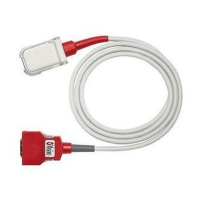4
6688F-eIFU-0818
en
M-LNCS® / LNCS® Specialty Sensors
Adult, Pediatric, Infant, and Neonatal SpO2 Disposable Sensors
DIRECTIONS FOR USE
Single patient use only
LATEX
Not made with natural rubber latex Non sterile
Prior to using this sensor, the user should read and understand the Operator’s Manual for the Device
and this Directions for Use.
INDICATIONS - When Used With Masimo Set® and Masimo compatible Pulse Oximeters:
The M-LNCS®, LNCS® Adult, Pediatric, Infant and Neonatal Specialty sensors are indicated for continuous noninvasive
monitoring of functional oxygen saturation of arterial hemoglobin (SpO2) and pulse rate (measured by an SpO2 sensor) for
use with adult, pediatric, infant, and neonatal patients during both no motion and motion conditions, and for patients who
are well or poorly perfused in hospitals, hospital-type facilities, mobile, and home environments.
INDICATIONS- When used with Nellcor® and Nellcor Compatible Pulse Oximeters:
The M-LNCS, LNCS Adult, Pediatric, Infant, and Neonatal Specialty sensors are indicated for the continuous noninvasive
monitoring of functional oxygen saturation of arterial hemoglobin (SpO2) and pulse rate (measured by an SpO2 sensor) for
use with adult, pediatric, infant, and neonatal patients in hospitals, hospital-type facilities, mobile, and home environments.
CONTRAINDICATIONS
M-LNCS, LNCS Specialty sensors are contraindicated for patients who exhibit allergic reactions to foam rubber products and/
or adhesive tape.
CAUTION: WITH SPECIALTY SENSORS, THE SENSOR OFF DETECTION PERFORMANCE MAY BE COMPROMISED.
DESCRIPTION
These Specialty sensors enable the algorithms to give new data higher priority than old data regardless of the averaging,
sensitivity, or FastSat setting. This results in a faster and more sensitive response to physiological changes.
The M-LNCS, LNCS Specialty sensors are for use with devices containing Masimo SET® oximetry (Version 4.1 or higher) or
licensed to use M-LNCS, LNCS Specialty sensors and also with Nellcor and Nellcor compatible pulse oximeters, except Nellcor
OxiMax® enabled devices. Consult individual device manufacturer for compatibility of particular device and sensor models.
Each device manufacturer is responsible for determining whether its devices are compatible with each sensor model.
When used with Nellcor and Nellcor compatible Pulse Oximeters, M-LNCS, LNCS Specialty sensors will not enable the
algorithms to give new data higher priority than old data.
The M-LNCS, LNCS Specialty sensors have been veried on Masimo SET Oximetry Technology and on Nellcor’s N-200 Pulse
Oximeter.
WARNING: Masimo sensors and cables are designed for use with devices containing Masimo SET® oximetry or licensed to
use Masimo sensors.
WARNINGS, CAUTIONS, AND NOTES
• All sensors and cables are designed for use with specific monitors. Verify the compatibility of the monitor, cable and
sensor before use, otherwise degraded performance and/or patient injury can result.
• The site must be checked frequently or per clinical protocol to ensure adequate adhesion, circulation, skin integrity and
correct optical alignment.
• Exercise caution with poorly perfused patients; skin erosion and pressure necrosis can be caused when the sensor is not
frequently moved. Assess site as frequently as every (1) hour with poorly perfused patients and move the sensor if there
are signs of tissue ischemia.
• Circulation distal to the sensor site should be checked routinely.
• During low perfusion, the sensor site needs to be assessed frequently for signs of tissue ischemia, which can lead to
pressure necrosis.
• With very low perfusion at the monitored site, the reading may read lower than core arterial oxygen saturation.
• Do not use tape to secure the sensor to the site; this can restrict blood flow and cause inaccurate readings. Use of
additional tape can cause skin damage, and/or pressure necrosis or damage the sensor.
• Sensors applied too tightly or that become tight due to edema will cause inaccurate readings and can cause pressure
necrosis.
• Misapplied sensors or sensors that become partially dislodged may cause incorrect measurements.
• Misapplications due to wrong sensor type can cause inaccurate or no readings.
• Venous congestion may cause under reading of actual arterial oxygen saturation. Therefore, assure proper venous
outflow from monitored site. Sensor should not be below heart level (e.g. sensor on hand of a patient in a bed with arm
dangling to the floor).
• Venous pulsations may cause erroneous low SpO
2 readings (e.g. tricuspid value regurgitation).
• The pulsations from intra-aortic balloon support can be additive to the pulse rate on the oximeter pulse rate display.
Verify patient’s pulse rate against the ECG heart rate.
• The sensor should be free of visible defects, discoloration and damage. If the sensor is discolored or damaged,
discontinue use. Never use a damaged sensor or one with exposed electrical circuitry.

